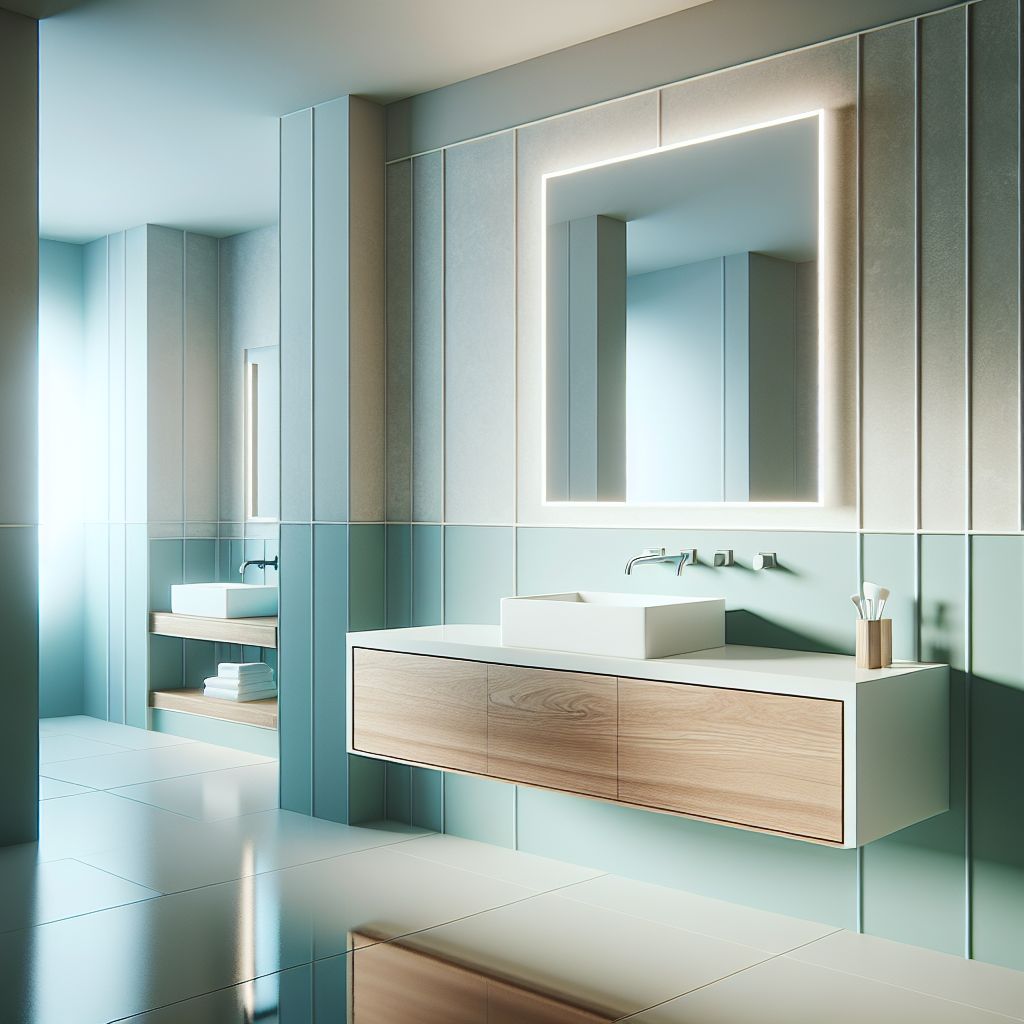
Key Takeaways
- A fresh coat of paint or stain can make an old bathroom vanity look brand new.
- Proper preparation, including cleaning, sanding, and priming, is essential for a quality finish.
- Choosing the right paint or stain is essential for both aesthetics and durability.
- Even beginners can achieve professional results with the right tools and techniques.
- Regular maintenance can extend the life of your refinished vanity and keep it looking great.
Transform Your Bathroom Vanity with Easy Refinishing
Ever walked into your bathroom and felt a little uninspired by the tired-looking vanity staring back at you? It’s a common feeling, but here’s the good news: with a little elbow grease and some creativity, you can transform that weary washstand into a stunning centerpiece. And the best part? You can do it yourself! Let’s dive into how you can revamp your bathroom vanity and give it a new lease on life.
The Magic of a Fresh Finish
Imagine your vanity going from drab to fab with just a few coats of paint or a fresh stain. It’s not just about looks; a new finish can also protect the wood from moisture and wear. But the real magic happens when you step back and see how this simple change can completely alter the vibe of your entire bathroom.
Now, let’s roll up our sleeves and get to the heart of the matter. Refinishing your bathroom vanity is a rewarding project that will not only save you money but also infuse your space with a touch of personal style.
Gather Your Supplies
Before we start transforming your vanity, you’ll need to gather some supplies. Trust me, having everything on hand before you begin will make the process much smoother. No one likes to run to the store mid-project because they forgot something important!
The Essentials List
For a successful vanity refinishing project, you’ll need:
- Sandpaper (various grits)
- Primer (if painting)
- Paint or stain
- Topcoat (polyurethane or similar)
- Quality brushes or rollers
- Painter’s tape
- Drop cloths or plastic sheeting
- Screwdriver (for removing hardware)
These are just the basics. Depending on your specific vanity and the look you’re going for, you might need additional items like wood filler, a paint sprayer, or decorative hardware.
Choosing the Right Paint or Stain
Choosing the right finish for your vanity is essential. You want something that looks great but also stands up to the humidity and use of a bathroom. For paint, go for a semi-gloss or high-gloss finish. These are not only durable but also easy to clean. When it comes to stains, pick one that complements the wood and the overall color scheme of your bathroom.
- Water-based paints are easy to clean up and have less fumes.
- Oil-based paints are more durable but take longer to dry and have stronger odors.
- Stains can highlight the natural beauty of the wood but may require more maintenance.
Remember, the finish you choose will set the tone for your bathroom, so take your time and pick something you’ll love for years to come.
Preparations Before the Transformation
Alright, you’ve got your supplies, and you’re eager to start. But hold on! Proper preparation is the key to ensuring that your refinishing project goes off without a hitch.
Cleaning and Prepping the Area
First things first, you need to clean your vanity thoroughly. Any dirt or grease can prevent the new finish from adhering correctly. Use a mild detergent and water, then let the wood dry completely. Next, protect the surrounding area with drop cloths or plastic sheeting. This will save you a lot of cleanup later on.
Then, it’s time to remove the doors, drawers, and hardware. A simple screwdriver will do the trick. Keep all the screws and hardware in a bag so you don’t lose anything. If you’re planning to replace the hardware, now’s the time to fill any old holes with wood filler.
Now you’re set up for success. Your vanity is clean, your workspace is protected, and all removable parts are set aside.

Step-by-Step Guide to Refinishing Your Bathroom Vanity
Step 1: Sanding: The Foundation of a Smooth Finish
You’ve got your vanity cleaned and cleared. Now, it’s time to make some dust. Sanding is all about prepping your vanity’s surface so that your new finish has something to hold onto. It’s the step that separates a good refinishing job from a great one.
Start with a coarse sandpaper to strip away the old finish and smooth out any rough spots. Then, work your way up to a finer grit for a polished surface. Always sand in the direction of the wood grain to avoid scratches that could show up under your new finish. And remember, the goal here is to create a smooth surface, not to sand down to the bare bones of your vanity.
Step 2: Painting or Staining: Bringing Color to Your Vanity
Now comes the fun part—adding color! Whether you’re painting or staining, this is where you get to see your vision come to life. But before you dip that brush into the paint, make sure you’ve got a game plan.
Applying Your Chosen Finish
If you’re painting, apply a primer first. It’ll help your color coat stick better and last longer. When it’s time for the paint, go with thin, even coats. It might take a couple of layers to get full coverage, but the result will be much smoother than one thick coat. For staining, apply the stain with a brush or rag and wipe away the excess for an even tone.
Patience is your friend here. Rushing might get the job done faster, but it won’t get it done better.
Step 3: Sealing for Protection and Durability
Once the paint or stain is completely dry, apply a topcoat to protect the wood. The topcoat acts as a barrier, shielding the vanity surface from moisture, stains, and daily wear and tear. This is especially important in a bathroom where the vanity is exposed to water and humidity.
Step 4: Reassembly and Final Touches
Once everything is dry, it’s time to put everything back together. But before you do, take a moment to admire your handiwork. Looks pretty good, doesn’t it? That’s because you took the time to do it right.
Putting it All Back Together
Reattach the doors and drawers, and screw in the hardware. If you’re using new knobs or pulls, this is where you’ll see how much of a difference those little details can make. They’re like the cherry on top of your refinishing sundae.
Step 5: Accessorizing Your Refinished Vanity
With your vanity back in place, it’s time to accessorize. Maybe a new faucet? Or perhaps some stylish baskets underneath for storage? These finishing touches are what make the space uniquely yours.

Bathroom Vanity Refinishing Tips and Techniques
Refinishing a bathroom vanity can refresh the whole look of your bathroom. Learning the right tips and techniques makes the process easier and more satisfying. With these tips, you can turn your bathroom vanity into a standout feature that enhances the entire space.
Choosing the Right Refinishing Method
To choose the right refinishing method for your bathroom vanity, first look at the material and condition of the surface. For wood vanities, painting or staining with a protective topcoat works well. For laminate, use a specialized paint or refinishing kit. Check for any damage and pick a method that will be durable and match the look you want.
Tips for Even Coats and Quick Drying
Here are a few tips to ensure your finish is as smooth as glass:
- Use a high-quality brush or roller to avoid bristle marks or lint.
- Keep a wet edge; don’t let the paint dry before you blend in a new stroke.
- Let each coat dry thoroughly before applying the next one.
Maintenance: Keeping Your Vanity Looking New
Maintenance might sound like a chore, but it’s really about preserving your hard work and keeping that vanity looking as good as the day you refinished it. Let’s not forget, the journey doesn’t end once your vanity looks stunning. To keep it that way, you need to know how to care for it properly.
Best Practices for Cleaning and Care
For daily upkeep, a soft cloth and a bit of mild soap should do the trick. Avoid harsh chemicals or abrasive cleaners that can damage the finish. If you’ve used a water-based paint or stain, a little bit of furniture wax every now and then can add an extra layer of protection against moisture and wear.
When to Touch Up Your Finish
Even with the best care, life happens. You might find a scratch or a chip here and there. The key is to touch it up sooner rather than later to prevent water damage or further chipping. Keep a small can of your finish on hand for quick fixes, and your vanity will continue to look fresh for years.
Now that you’re armed with the know-how to keep your vanity in top shape, let’s address some common questions you might have about the refinishing process.

Frequently Asked Questions
Can you refinish a vanity without sanding?
Technically, yes, you can use a ‘deglosser’ or a liquid sander, but I wouldn’t recommend skipping the sanding step. Sanding not only helps the new finish stick better, but it also gives you a chance to smooth out any imperfections for a more professional look.
What kind of paint is best for bathroom vanities?
I suggest using a semi-gloss or high-gloss paint designed for bathrooms or kitchens. These types of paints are more resistant to moisture and easier to clean, which is exactly what you want in a bathroom setting.
How do you prevent brush strokes when refinishing a vanity?
The key to avoiding brush strokes is to use a high-quality brush and to apply thin, even coats of paint. If you’re still seeing strokes, a foam roller or a paint sprayer can give you a smoother finish.
Is it better to spray or brush paint a bathroom vanity?
Both methods have their pros and cons. Spraying will give you a smoother finish and is faster, but it requires more prep to protect your space from overspray. Brushing takes more time but gives you more control, especially in tight spaces.
Can you change the color of a vanity without replacing it?
Absolutely! That’s the beauty of refinishing. You can go from dark to light, light to dark, or any color in between. Just make sure you prep properly and use the right products for the best results.





Leave a Reply